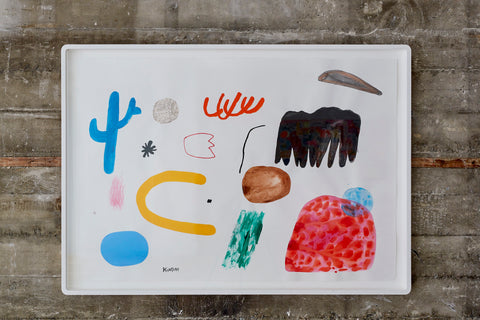How To Frame - FAQ

Above Image: "The Turf" Edition of 350. Framed to the edge of print (no mounting or float).
We frequently receive questions about framing, and wanted to answer some of the most popular ones in case you're wondering about them too. Most of our print editions are done on beautiful, textured watercolor papers. We hope that this mini guide can come in handy for art that you may need to have framed, from us or anywhere else.
If you want to fast forward through the process, we also offer archival, museum-quality framing for US clients in our shop.
Okay, let's dive in.
How Should I Frame My Work?
Framing is completely up to each client, and there is NO wrong way to frame in our opinion. We've seen clients use bright red, acrylic, the whole rainbow; choose what makes you happiest.
Sometimes we're asked about specifications based on how the artist intended her work to be seen. In that case, we love white and natural wood frames. Kindah's work is so bright and expansive, so pairing it with a simple frame can set the stage for the artwork to shine.

Above Image: Original work on paper with deckled edges, 2019. Floated Frame by Small Works.
To Float or Not To Float?
"Floating" in framing terms basically means that the artwork is slightly levitating (with the use of mounting materials, not David Blaine). This creates a lovely effect that adds dimension, and can accentuate handmade paper. For instance, a lot of Kindah's original works on paper have deckled edges (see image above). A floating frame can really highlight this lovely detail and make it POP.
Should I Go With A Professional Framer or DIY (Do It Yourself)
You may be comfortable framing artwork yourself, or even making the frame from scratch (we have seen some lovely work handmade by clients). If you decide to go with a professional job, we always suggest working with a local framer with good ratings because they typically offer free consultations. That way you can see your artwork paired with multiple samples all in one place before making a decision.
Make It Archival
It's good to ask if the materials being used are archival. Most framers offer this, but basically it ensures that no materials will be used that can affect the longevity of your artwork. It's also a good idea to go over if the artwork will be safe, should you ever want to switch out the frame.
Extra Tips
When hanging oversized or large frames, it may require finding a stud in the wall or going through brick, depending on wall structure. If you need a helping hand, there are art installers who can come in and hang the work in your home, and they typically work pretty quickly making the process a huge time saver.
Hope this helps and feel free to reach out with any other questions.
x Kindah Khalidy Studio
